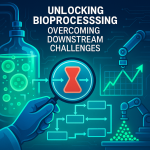🔧 Experts suggest developing purpose-built technologies, especially in chromatography, to improve vector production.
🤖 Integrating AI and automation can enhance reproducibility and scalability, ultimately meeting growing market needs. Efficient solutions are vital for future growth in this sector.
Introduction:
This article discusses the challenges the biopharmaceutical industry faces in producing lentiviral vectors, highlighting the significance of adopting purpose-built processing technologies to meet increasing demand and improve efficiency in vector manufacturing.
- There is a growing demand for lentiviral vectors, driven by advancements in therapy development, particularly in immunotherapies and vaccines.
- Current lentiviral vector production processes are complex and face several challenges due to the vectors’ sensitivity to shear forces and physicochemical conditions.
- Chromatography methods traditionally employed in the purification of lentiviral vectors yield only a 30-40% recovery rate, indicating a need for more optimized approaches.
- VIVEbiotech is exploring the integration of artificial intelligence (AI) and automation to enhance the reproducibility and predictability of their production processes.
- There is an urgent requirement for the biopharma industry to access innovative manufacturing technologies that can improve scalability and cost-effectiveness in lentiviral vector production.
Conclusion:
The article emphasizes the need for the development and implementation of specialized processing technologies in the production of lentiviral vectors, which is essential for overcoming current production challenges and meeting the increasing industry demands. Future advancements, particularly through AI and automation, are anticipated to play a crucial role in enhancing production efficiency and ensuring the viability of therapeutic applications.



